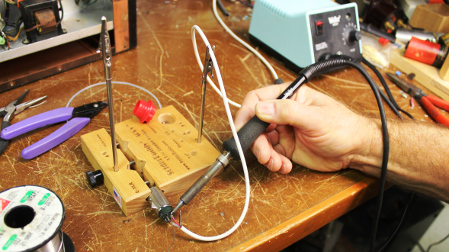Review: SolderBuddy ACS-V
If you’re not familiar with Lee Tingler’s “SolderBuddy” products, they are a family of rather inexpensive devices designed to assist in the installation of solder-type audio connectors. I’m no stranger to the SolderBuddy, having reviewed Tingler’s first such product in the Oct. 1, 2008 TV Technology,and another slightly different model in the Dec. 21, 2011 issue.

The SolderBuddy ACS-V allows XLR and other connectors to be secured in the horizontal plane for easier soldering.
Tingler has recently added a new SolderBuddy to his growing lineup of soldering aids, the ACS-V. It was designed as a replacement for the previous SolderBuddy ACS and ))SPK(( models, which have now been discontinued. Tingler is always open to feedback from users of his products and based on such information, reworked the ACS to incorporate some of these. The result is the new ACS-V.
FEATURES
Just like earlier SolderBuddy products, the new ACS-V is constructed from a solid block of hardwood (European beech) with “labels” precisely created via laser engraving. When fully closed, it’s approximately 4x4x1/2-inches. The block is divided into two sections, a 3-inch front with precisely drilled openings for 1/4-inch phone plugs, RCA phono plugs and a 3.5mm male connector. There’s also a 5/8-inch “well” with a screw cap for small screws, solder lugs and the like. The rear-most 1-inch section of the ACS-V is equipped with a long thumbscrew and pair of guide pins that allow it to move away from the front section to create a “vise” for accommodating XLR, Speakon, D-sub or other large connector bodies (there are three “diamond” cutouts for such items; two on the top surface and one on the left side). When fully extended, the opening between the front and rear sections is about 1.5-inches.
The ACS-V is also equipped with holes to accommodate the alligator clips affixed to long posts that Tingler calls “Post N Clips.” These are used to keep cables in place while soldering operations are going on. Two of these are included with the ACS-V and additional “Post N Clips” can be purchased if needed. There’s also an insulation stripping gauge engraved into the rear section.
IN USE
Given the intuitive nature of the device (and having put two other “Solder-Buddies” through their paces), I really didn’t need specialized instructions for using the ACS-V. Actually, this new unit is very similar to the discontinued ))SPK(( model, with the biggest difference being the previously described “diamond” female XLR connector bodies. I chucked one in to begin my trial and immediately found that positioning such a connector in the horizontal plane makes it easier to do a neat soldering job, as there are no worries about the molten metal flowing by gravity to the bottom of the connector’s metal recesses and clumping there. I’m sure that most of us, when soldering XLRs without a vise or other holding aid, have kept the barrel parallel to the bench or whatever surface was handy, rather than trying to perform the operation with the connector “standing up.”
The XLR wiring was easily accomplished and I decided to try out the ACS-V for adding a 1/4-inch TRS plug to the other end of the cable now attached to the XLR. When setting things up for this operation, I noticed something that had escaped me previously; there was a very small horizontal opening in both halves of the SolderBuddy’s right-side surfaces. I was all set to insert the tip of the 1/4-inch plug in the labeled opening and bring in the solder and heated iron, but instead chucked the connector’s tip in the slot, thus placing it in a horizontal plane. As with the XLR, I found that soldering the 1/4-inch phone plug while it was held “sideways” was more natural than when attempting the operation when it was pointed downwards. I went back and read the instruction sheet provided with the ACS-V and found that the right-side slot was “borrowed” from the SolderBuddy RC (a model that I have not reviewed), and was provided in the ACS-V for securing Din, male XLR bodies, 3.5-mm “minnies,” and other connectors.
SUMMARY
Like the previous SolderBuddy units I’ve reviewed, the new ACS-V is well made and will serve the user for many years; provided he or she doesn’t accidentally use it for a soldering iron “rest;” then all bets are off. However, if you’re careless enough to put a hot iron on a piece of wood, you really shouldn’t be soldering.
The hardwood block that makes up the ACS-V is nice and dense and stayed put on my scuffed-up Masonite-topped workbench. However, you might want to think about adding an accessory—the NSB-A “non-slip base”—or perhaps some stick-on rubber feet if you’re going to be using it on slipperier surfaces such as Formica or metal. As mentioned in one of my earlier reviews, I find the SolderBuddy soldering aids easier to use than a much more expensive portable metal vise unit I purchased for this purpose a long time before Tingler started his SolderBuddy business. If you’re like me, the ACS-V will be seeing a lot of use while the expensive pivoting metal vise continues to collect dust. I could have bought a lot of solder for what I paid for that vise.
FAST FACTS:
Application: Wherever a “third hand” could be useful in the installation of solder-type audio connectors
Key Features: Versatile, accommodates a variety of connectors, attractive hardwood construction, compact size, and inexpensive
List Price: $46.95 (shipping included); a non-slip base, the NSB-A, is available for $4.75.
Contact: SolderBuddy
770-476-5337
www.solderbuddy.com
James O’Neal is a retired broadcast engineer and served asTV Technology’s technology editor for 10 years.
Get the TV Tech Newsletter
The professional video industry's #1 source for news, trends and product and tech information. Sign up below.
